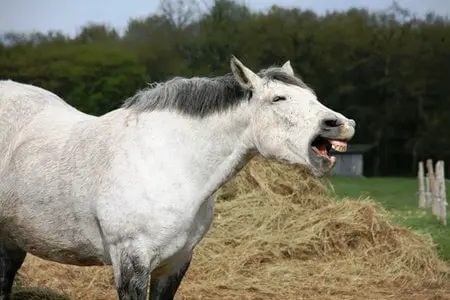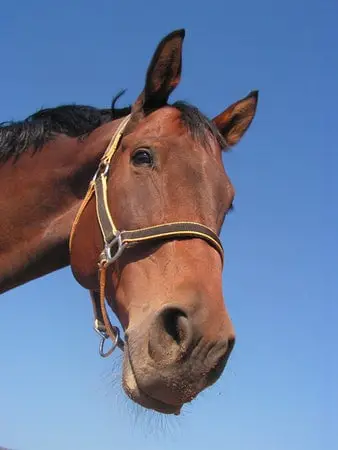Can you anhidrosis be correctly treated with beer? This article will answer your question as well as other questions you might have on the topic. Before we go on to the proper way to treat anhidrosis, let’s first focus on the condition anhidrosis and how it presents itself in horses.
What is Anhidrosis?
Anhidrosis can be described as the incapability of horses to sweat in all or some part of their body. It is also referred to as “non-sweating disease” or “dry coat syndrome”.
A horse can be partially anhidrotic, such that he can sweat a little bit but not enough to regulate his body temperature. A normal horse usually starts with partial anhidrosis then climbs up till it’s completely unable to sweat.
If your horse gets affected and not treated or taken care of properly, it may develop heatstroke, which can be fatal in horses. Horses maintain body temperature through sweating and if that ability is weakened or dead, intense heat can cause heatstroke and possible death. Anhidrosis appears to be more common in hot regions than temperate locations; in fact, horses that have anhidrosis will recover better if they are relocated to temperate and less humid regions.
Causes of Anhidrosis
Most people think that anhidrosis in horses is caused by the inability of the sweat glands to produce sweat, however, there’s a lot of debate around the subject. Dr. Laura Kellam, a university veterinarian, stated that the sweat glands in the horses are being overstimulated, she adds that “because of overstimulation by these chemicals in the body which we call neurotransmitters, at some point the glands stop working. It’s like they are getting too much information”.

The strange phenomenon behind over-stimulation is still appalling; some experts induce that it is because of the disproportion of dopamine in the horse.
There are different theories of the causes of anhidrosis, for instance, some may say the reason for this deficiency may be the cause of little chloride concentrations others may point out that it is due to the increased epinephrine level however there is no well-defined theory yet.
Symptoms of Anhidrosis
Anhidrosis is prevalent during the summer months and in places with high humidity, especially in horses that relocated from cool temperate regions to hot environments. The symptoms of anhidrosis are quite noticeable if you pay good attention to your horse. If your horse suddenly acts lazy or lethargic or shows discomfort in any way do not hesitate to call your veterinarian for diagnosis and treatment.
Obvious signs of the non-sweating disease are clear bald patches, slow gait, parched skin that wafers, a high rate of respiration, and increased body temperature. Horses that undergo partial anhidrosis sweat between the hind legs, along the neck, and under the saddle, it is not usually so in all the horses.
Some horses will show signs of sweating, but it’s not strong enough to cool them. Non-sweating can imply any type of sickness and not necessarily anhidrosis, so if you’ve noticed this it is good you call your vet to get a complete picture of the ailment. If you’ve discovered that your horse is not acting like his or her usual self, go to the veterinarian for proper advice or instructions.
Below are a few symptoms of anhidrosis;
- Loss of interest in food
- Reduction in the intake of water
- The horse becomes irritated and lethargic
- Difficulty in breathing especially after exercise
- Hair loss around the face and patchy hair coat
- The coat becomes dry and hot after exercise
- Thinning hair
- Sweating a little or no sweating at all.
How do you treat Anhidrosis in Horses?
It is good to detect the non-sweating disease early to avert a lengthy structural impairment of the sweat glands. Horses react differently to treatment; some treatment brings positive reactions on horses while some don’t seem to improve.

Treatments that are popularly used for treating horses with anhidrosis are supplements, acupuncture, and some useful home remedies like dark beer. Yes, it may surprise you but quite a number of people use beer to treat horses suffering from anhidrosis.
-
Dark beer
Giving dark beer to horses particularly Guinness stout beer has been a traditional system of treating anhidrosis as a result of the ingredients the beer holds like vitamin B (biotin, folic acid, thiamin, niacin and riboflavin, vitamin B6 & B12). These vitamins are pivotal for the proper operation of metabolic pathways, structuring of blood cells, metabolism of fats and carbohydrates to sustain a vibrant and strong coat.
The essential nutrients of beer are catalyzed in the body’s hindgut. If you are concerned about your horse getting drunk, don’t be, because they have enough enzymes which enable them to metabolize the alcohol content present in the beer in a short time.
Besides, their large size indicates that before they get drunk, they’ll have to drink a hefty load of beer.
Other treatments;
-
Supplements
They’re a bunch of additives that can enhance sweating in your horse, it might be difficult to choose but find the best one that you think is suitable and convenient for your horse. You can use One AC that contains a blend of vitamins which can help prompt sweating.
Some additives may start straight away and improve your horse’s health; others may wait till days or weeks before improvement kicks in. Other examples of these supplements are the Equiwinner Patches, True Sweat, and Platinum Refresh, and so on
-
Acupuncture
This is an old Chinese system of fixing small needles at vital energy points to eliminate obstructions or blockage in any part of the body. Some people believe that anhidrosis involves energy blockage in the spleen and lungs and so using acupuncture to treat anhidrosis may be effective to increase sweat production.
- You can fix air conditioners, fans around the horse’s settlement especially during the early hours of the day or evenings to regulate the horses’ body temperature.
- Giving electrolytes to horses can improve their health and can also ignite the need for horses to drink more water.
It is important to note that no supplement has been proven to be 100% accurate in the treatment of anhidrosis. You can take your horse to the veterinarian to carry out some blood tests to find the supplement that may work best for a horse. Still, the best cure would be moving your horse from that hot humid environment to a cooler region.
Controlling Anhidrosis
Even though there are no effective treatments to get rid of this disturbing condition, there are things you can do to regulate the horse’s body temperature. Once you have discovered an anhidrotic horse put him on a strict program and keep an eye out on him or her for improvement. You can manage an anhidrotic horse by;
- Transfer to a cooler region
- Permit access to water sources like ponds
- Combination of electrolytes and salt for the horse to retain the concentration of the electrolyte.
- Taking a light stroll with your horse (exercise) during the coolest part of the day
- Fixing of fans and air conditioners
- Provide fresh and clean water for drinking
- Monitor your horses during the day
- Call your vet and following his or her medical advice.
Final Thoughts
Caring and managing your horse when they aren’t at their optimal healthy state may be stressful. However, ensure you do the best you can and hope he/she will be strong enough to survive this ailment.

